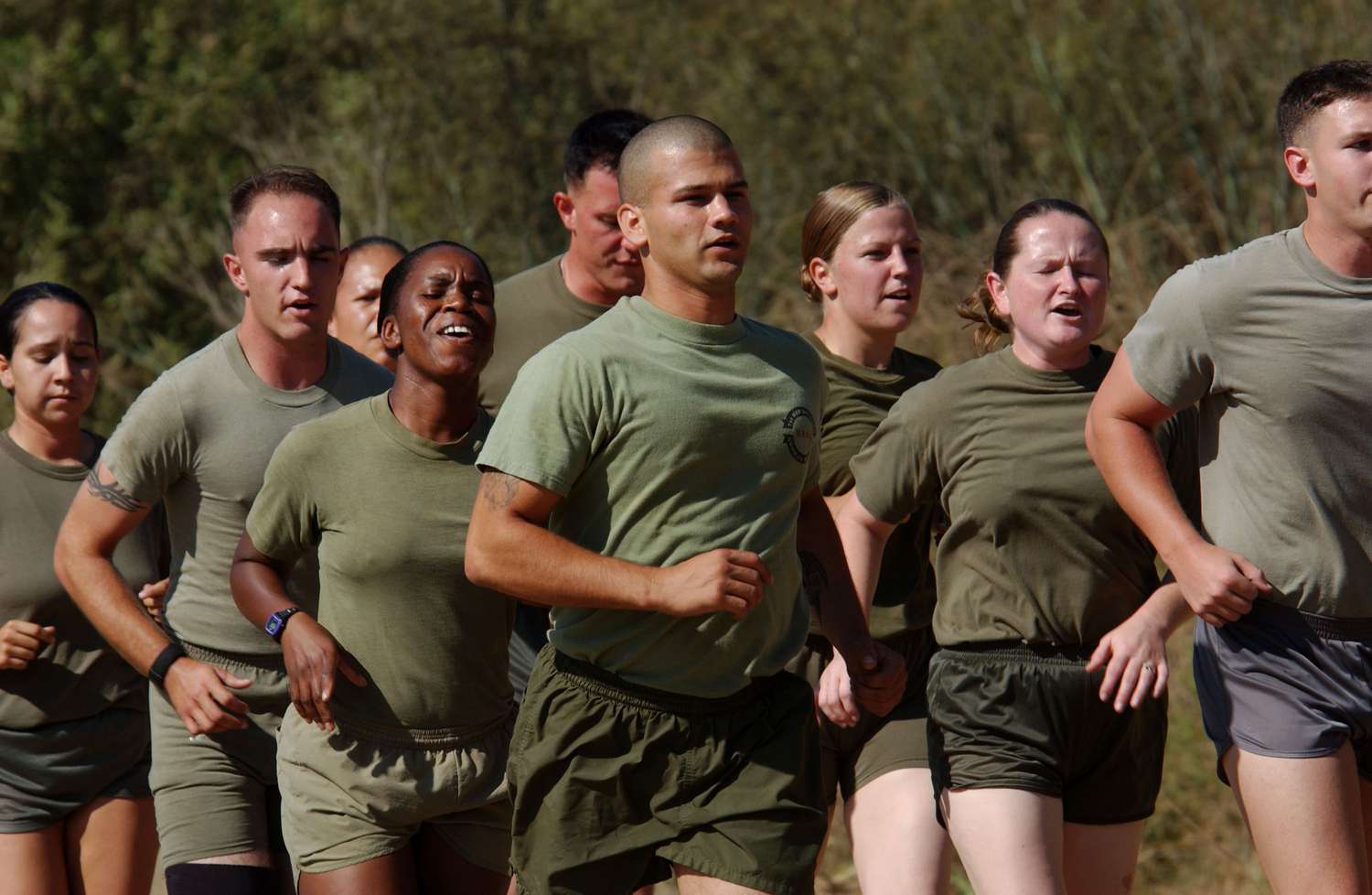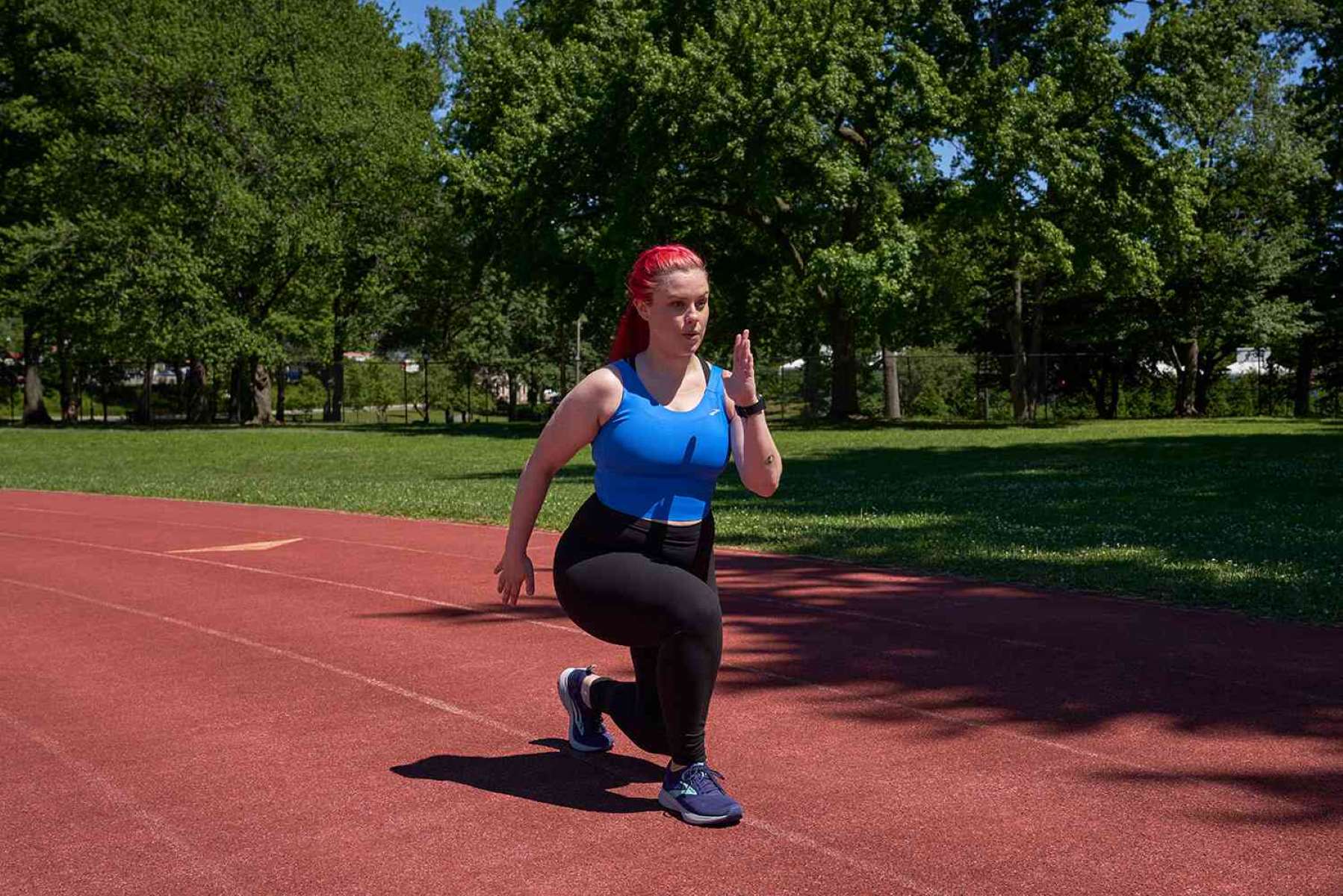

Featured
How Do You Develop Muscular Endurance
Modified: August 21, 2023
Develop muscular endurance with our featured exercise routines and training tips. Boost your stamina and achieve lasting results with our expert guidance.
Introduction
When it comes to fitness and strength training, developing muscular endurance is a key factor for achieving optimal performance. Muscular endurance refers to the ability of a muscle or group of muscles to exert force repeatedly without becoming fatigued. It plays a vital role in various physical activities, from endurance sports like long-distance running and cycling to everyday tasks such as carrying groceries or climbing stairs.
Improving muscular endurance not only enhances athletic performance but also promotes overall health and well-being. It allows you to perform repetitive movements for an extended period, leading to improved stamina, reduced risk of injuries, and increased muscle tone.
In this article, we will delve deeper into the concept of muscular endurance and explore the importance of incorporating it into your fitness routine. We will also discuss the factors that influence muscular endurance and provide practical tips on how to develop it effectively.
So, if you’re ready to take your physical fitness to the next level, let’s dive in!
Understanding Muscular Endurance
Muscular endurance is a specific component of muscular fitness that focuses on the ability of a muscle or group of muscles to sustain repeated contractions over an extended period. It is different from muscular strength, which is the maximum amount of force a muscle can generate in a single effort.
When you engage in activities that require muscular endurance, such as running, swimming, or performing high-repetition exercises, your muscles need to contract repeatedly without fatiguing too quickly. This endurance capacity is dependent on various physiological factors, including muscle fiber type, oxygen utilization, energy production, and muscle fiber recruitment.
There are two main types of muscle fibers that play a role in muscular endurance: slow-twitch (type I) and fast-twitch (type II) fibers. Slow-twitch fibers are more resistant to fatigue and can sustain contractions for longer periods. They are responsible for endurance activities such as long-distance running or cycling. Fast-twitch fibers, on the other hand, are better suited for explosive, strength-related movements but tend to fatigue more quickly.
Aside from muscle fiber type, oxygen utilization is another critical factor in muscular endurance. Oxygen is vital for ATP (adenosine triphosphate) production, which provides energy for muscle contractions. The more efficiently your muscles can utilize oxygen, the longer they can sustain contractions without fatigue.
Furthermore, energy production systems, such as the aerobic and anaerobic systems, play a role in muscular endurance. The aerobic system relies on oxygen to produce ATP and is primarily used during low to moderate intensity activities. On the other hand, the anaerobic system kicks in during high-intensity activities where oxygen availability is limited, relying on stored energy sources for ATP production, such as glycogen.
Overall, understanding the components that contribute to muscular endurance is crucial for developing targeted training strategies and achieving optimal performance. In the next section, we will discuss the importance of improving muscular endurance in the context of overall fitness goals.
The Importance of Muscular Endurance in Fitness
Muscular endurance plays a crucial role in overall fitness and performance. Whether you’re an athlete or someone looking to improve their fitness level, developing muscular endurance can bring numerous benefits:
- Enhanced Stamina: Muscular endurance allows your muscles to sustain contractions for longer periods, improving your stamina and endurance during physical activities. This can be especially beneficial for endurance sports like running, swimming, or cycling, where prolonged effort is required.
- Reduced Fatigue: As you improve your muscular endurance, you’ll notice a decrease in muscle fatigue during activities. This means you’ll be able to perform at a higher intensity for an extended duration without feeling exhausted.
- Increased Muscle Tone: Muscular endurance training can help promote muscle definition and tone. It stimulates muscle fibers, leading to improved muscle definition and a leaner appearance.
- Prevention of Injuries: Stronger muscles with good endurance can help prevent injuries during physical activities. By improving the endurance of muscles surrounding your joints, you enhance stability and reduce the risk of strains, sprains, and other injuries.
- Improved Metabolic Health: Muscular endurance exercises, especially those involving larger muscle groups, can boost your metabolism. This leads to increased calorie burn, improved weight management, and enhanced overall metabolic health.
- Functional Fitness: Muscular endurance training prepares your muscles for everyday tasks and activities. It improves your ability to perform repetitive movements and tasks with ease, such as carrying groceries, climbing stairs, or participating in active hobbies.
Furthermore, muscular endurance training complements other aspects of fitness, such as muscular strength and cardiovascular health. By incorporating a well-rounded training routine that includes endurance-focused exercises, you can achieve a balanced level of fitness and optimize your performance in various physical activities.
Now that we understand the importance of muscular endurance in fitness, let’s explore the factors that can affect one’s endurance capacity in the next section.
Factors Affecting Muscular Endurance
Multiple factors can influence an individual’s muscular endurance capacity. Understanding these factors can help in designing effective training programs and optimizing performance. Here are some key factors that affect muscular endurance:
- Muscle Fiber Type: The proportion of slow-twitch (type I) and fast-twitch (type II) muscle fibers can impact muscular endurance. Slow-twitch fibers have a higher capacity for endurance due to their resistance to fatigue, while fast-twitch fibers are better suited for high-intensity, explosive movements.
- Body Composition: Body composition, including muscle mass and body fat percentage, can play a role in muscular endurance. Higher muscle mass tends to correlate with improved endurance, while excess body fat can negatively impact endurance performance.
- Oxygen Utilization: Efficient oxygen utilization is crucial for sustained muscle contractions. Factors such as cardiovascular fitness, lung capacity, and the ability to deliver oxygen to the muscles impact endurance capacity. Regular cardiovascular exercise can improve oxygen utilization.
- Energy Production: The body’s energy systems, including the aerobic and anaerobic systems, are essential for muscular endurance. The aerobic system relies on oxygen for energy production, while the anaerobic system predominantly utilizes stored energy sources. Developing both systems contributes to endurance capacity.
- Training Status: The level of training and conditioning directly affects muscular endurance. Regular training and gradually increasing the intensity and volume of exercises can improve endurance capacity over time.
- Training Methods: The specific training methods and exercises used can impact muscular endurance. Different training approaches, such as high-repetition sets, circuit training, or interval training, can target and improve endurance capacity.
- Nutrition and Hydration: Proper nutrition and hydration play a vital role in muscular endurance. A well-balanced diet that includes carbohydrates for energy, protein for muscle repair, and adequate fluid intake can optimize endurance performance.
- Rest and Recovery: Sufficient rest and recovery are crucial for developing muscular endurance. Without proper recovery periods, the muscles can become fatigued, leading to a decline in performance. Adequate sleep, rest days, and proper post-workout nutrition are essential for optimizing endurance gains.
By considering these factors and tailoring training programs accordingly, individuals can improve their muscular endurance and optimize their performance in various physical activities.
How to Develop Muscular Endurance
Developing muscular endurance requires a strategic and progressive approach to training. By incorporating the following strategies, you can effectively enhance your endurance capacity:
- Resistance Training: Perform exercises with lighter weights and higher repetitions to target muscular endurance. Aim for 12-15 repetitions per set, focusing on maintaining good form throughout the entire set.
- Circuit Training: Circuit training involves performing a series of exercises with minimal rest in between. This helps improve both cardiovascular fitness and muscular endurance. Design a circuit that includes a combination of strength exercises targeting various muscle groups.
- High-Intensity Interval Training (HIIT): HIIT combines short bursts of intense exercise with brief recovery periods. Incorporating HIIT into your routine can improve aerobic capacity and muscular endurance. Examples include sprint intervals, jump squats, and kettlebell swings.
- Bodyweight Exercises: Bodyweight exercises are an effective way to improve muscular endurance. Exercises like push-ups, squats, lunges, planks, and burpees engage multiple muscle groups and challenge your endurance capacity.
- Endurance-Specific Exercises: Incorporate exercises specifically designed to improve muscular endurance. Examples include cycling, running, swimming, rowing, or stair-climbing. Gradually increase the duration or intensity of these exercises to progressively overload the muscles.
- Proper Recovery and Rest: Allow adequate time for rest and recovery between workouts. This allows your muscles to repair and adapt, leading to improved endurance capacity. Aim for at least one or two rest days per week and prioritize quality sleep.
- Nutrition and Hydration: Consume a well-balanced diet that supports your endurance training. Ensure an adequate intake of carbohydrates for energy, lean proteins for muscle repair, and hydrate properly before, during, and after workouts to maintain optimal performance.
It’s important to note that developing muscular endurance is a gradual process. Start with realistic goals and gradually increase the intensity, volume, and duration of your workouts as your endurance improves. Consistency and patience are key to long-term success.
By incorporating these strategies into your training routine and staying committed to your goals, you can significantly enhance your muscular endurance and take your fitness to new heights.
Resistance Training
Resistance training is a crucial component of developing muscular endurance. By incorporating this training method into your routine, you can effectively target and strengthen your muscles for improved endurance capacity.
Here are some key points to consider when implementing resistance training for muscular endurance:
- Lighter Weights, Higher Repetitions: When focusing on muscular endurance, opt for lighter weights and higher repetitions. This allows you to perform more repetitions without compromising form or fatiguing too quickly. Aim for a weight that allows you to comfortably complete 12-15 repetitions per set.
- Full Range of Motion: Perform exercises through the full range of motion to engage the targeted muscles fully. This ensures that you are targeting and strengthening the muscles needed for endurance activities. Maintain proper form and control throughout each repetition.
- Circuit Training: Incorporate resistance exercises into a circuit training format for an additional endurance challenge. Combine multiple exercises targeting different muscle groups, and perform them in succession with minimal rest. This helps improve cardiovascular fitness while challenging your muscles’ endurance capacity.
- Progressive Overload: Gradually increase the intensity of your resistance training over time. This can be done by adding weight, increasing the number of repetitions, or performing more sets. Progressive overload ensures that your muscles continue to adapt and grow stronger, boosting your muscular endurance.
- Compound Exercises: Choose compound exercises that engage multiple muscle groups simultaneously. These exercises, such as squats, lunges, push-ups, and rows, enhance functional strength and endurance. They mimic real-life movements and improve the efficiency of your muscles in performing various tasks.
- Proper Rest and Recovery: Allow sufficient rest and recovery between resistance training sessions. This allows your muscles to repair and adapt, leading to improved endurance. Aim for at least 48 hours of rest between training sessions targeting the same muscle groups.
Remember, consistency is key when it comes to resistance training for muscular endurance. Aim to incorporate resistance training exercises at least two to three times per week, gradually increasing the intensity and volume over time. Additionally, ensure proper form, warm-up adequately, and listen to your body to avoid any injuries.
By incorporating resistance training into your fitness routine, you can effectively target and improve your muscular endurance, enhancing your overall physical performance.
Circuit Training
Circuit training is a highly effective training method for improving muscular endurance. This form of exercise combines strength training and cardiovascular conditioning, challenging both your muscles and your cardiovascular system simultaneously.
Here are some important points to consider when incorporating circuit training into your routine:
- Exercise Selection: Choose a variety of exercises that target different muscle groups. Include exercises for the upper body, lower body, and core to ensure a well-rounded workout. Examples include push-ups, squats, lunges, planks, burpees, and kettlebell swings.
- Work-to-Rest Ratio: Design your circuit to include a specific amount of work and rest time. For example, perform each exercise for a set amount of time or number of repetitions, followed by a short rest period before moving on to the next exercise. Aim for a challenging but sustainable work-to-rest ratio.
- Minimal Rest: Minimize rest time between exercises to keep your heart rate elevated and maintain the cardiovascular challenge. This helps improve both muscular strength and endurance. However, listen to your body and adjust the rest periods if necessary to maintain proper form and prevent fatigue-related injuries.
- Progression and Variation: Gradually increase the intensity, duration, or difficulty of your circuit training sessions. This can be achieved by adding more exercises, increasing the repetitions or time for each exercise, or incorporating more challenging variations of the exercises. Progression ensures constant adaptation and improvement.
- Include Cardiovascular Exercises: Integrate cardiovascular exercises such as jumping jacks, high knees, or skipping rope into your circuit. This adds an extra challenge and promotes cardiovascular conditioning, which is vital for improving endurance capacity.
- Efficient Time Management: Circuit training is known for its efficiency, as it allows you to work multiple muscle groups and cardiovascular fitness in a single session. It can be particularly beneficial for individuals with a limited amount of time to dedicate to their workouts.
When performing circuit training, it is essential to maintain proper form and technique to prevent injuries. Focus on quality movements rather than rushing through the exercises. If needed, modify exercises or adjust the intensity to match your fitness level.
By incorporating circuit training into your fitness routine, you can improve muscular endurance, cardiovascular fitness, and overall strength. This versatile training method keeps your workouts engaging, challenging, and time-efficient, making it a valuable addition to your exercise regimen.
High-Intensity Interval Training (HIIT)
High-Intensity Interval Training (HIIT) is a popular training method that combines short bursts of intense exercise with brief recovery periods. This form of training is highly effective for improving muscular endurance and cardiovascular fitness.
Here are some important points to consider when incorporating HIIT into your routine:
- Interval Structure: HIIT involves alternating between periods of high-intensity exercise and active recovery. For example, you might perform 30 seconds of all-out effort, followed by 15-30 seconds of active recovery, such as jogging or walking. This cycle is repeated for a designated number of rounds.
- Intensity Level: During the high-intensity intervals, you should aim to work at maximum effort. This means challenging yourself and pushing your limits. The goal is to elicit a high heart rate and demand a significant amount of effort from your muscles.
- Exercise Selection: Choose exercises that engage multiple muscle groups and elevate your heart rate. Examples include sprints, burpees, mountain climbers, jump squats, and kettlebell swings. Incorporate a variety of exercises to keep the workout engaging and target different muscle groups.
- Duration and Frequency: HIIT sessions are typically shorter in duration compared to traditional steady-state cardio workouts. Aim for 15-30 minutes of HIIT, including warm-up and cool-down periods. Depending on your fitness level, incorporate HIIT workouts into your routine 1-3 times per week.
- Progression: As with any form of training, progression is important in HIIT. Gradually increase the intensity or duration of your high-intensity intervals as you become fitter and more accustomed to the demands of the workout. However, be mindful not to overexert yourself or compromise your form.
- Variation: Keep your HIIT workouts interesting by incorporating different exercises, timing intervals, or training modalities. This helps prevent boredom and ensures that your muscles are continuously challenged and adapting to new stimuli.
- Proper Warm-up and Cool-down: Prioritize a dynamic warm-up to prepare your body for the high-intensity work ahead. Similarly, include a thorough cool-down to gradually bring your heart rate down and allow for proper recovery.
It’s important to note that HIIT workouts can be demanding and may not be suitable for everyone, especially individuals with certain health conditions. If you’re new to HIIT or have any concerns, consult with a healthcare professional or fitness expert before incorporating it into your routine.
By incorporating HIIT into your workouts, you can improve your muscular endurance, cardiovascular fitness, and calorie burn, all within a shorter time frame. It’s an efficient and effective training method to challenge your body and elevate your endurance capacity.
Bodyweight Exercises
Bodyweight exercises are a fantastic way to develop muscular endurance without the need for any equipment or weights. These exercises utilize the resistance provided by your own body weight to challenge your muscles and improve your endurance capacity.
Here are some key points to consider when incorporating bodyweight exercises into your routine:
- Variety of Exercises: There is a wide range of bodyweight exercises to choose from, targeting different muscle groups. Include exercises such as push-ups, squats, lunges, planks, burpees, bicycle crunches, and mountain climbers. Mixing up the exercises will help engage various muscle groups and prevent boredom.
- Controlled Range of Motion: Focus on maintaining good form and performing exercises through a controlled range of motion. This allows for the full engagement of the targeted muscles and ensures proper muscle activation, maximizing the endurance benefits.
- Progression: Bodyweight exercises can be modified or progressed based on your fitness level. Start with easier variations of exercises and gradually progress to more challenging variations. Progression can be achieved by increasing repetitions, adding pauses or tempos to movements, or attempting more advanced variations like single-leg squats or one-arm push-ups.
- Circuit Training: Incorporate bodyweight exercises into a circuit training format to create an intense and efficient workout. Perform a set number of repetitions or time for each exercise, and then move on to the next without significant rest. This promotes cardiovascular fitness and challenges your muscles to improve endurance.
- Interval Training: Combine bodyweight exercises with interval training principles for an added challenge. Alternate between high-intensity exercises and short rest periods to elevate your heart rate and improve both cardiovascular fitness and muscular endurance.
- Flexibility and Mobility Exercises: Include exercises that enhance flexibility and mobility alongside bodyweight exercises. Improved flexibility and mobility can optimize your movement efficiency, prevent injuries, and enhance your overall endurance capacity.
- Proper Form and Breathing: Pay attention to proper form and technique during bodyweight exercises. Maintain a neutral spine, engage the core muscles, and focus on controlled movements. Proper breathing techniques, such as exhaling during the exertion phase and inhaling during the relaxation phase, can also enhance performance and endurance.
Bodyweight exercises offer a convenient and accessible way to improve muscular endurance. They can be performed anywhere, making them ideal for home workouts or when traveling. Incorporating these exercises into your routine will challenge your muscles, boost endurance, and help you achieve your fitness goals.
Endurance-Specific Exercises
Endurance-specific exercises are activities that closely mimic the movements and demands of endurance sports or activities. By incorporating these exercises into your training routine, you can specifically target and improve your muscular endurance for your chosen activity.
Here are some key points to consider when incorporating endurance-specific exercises:
- Sport-Specific Training: Identify the key movements and muscle groups used in your chosen endurance activity, whether it’s running, cycling, swimming, or another sport. Design exercises that replicate those movements to improve the endurance capacity of the involved muscles.
- Long-Duration Exercises: Increase the duration of your endurance-specific exercises gradually. For example, if you’re training for a marathon, include long runs to build endurance. If you’re preparing for a cycling event, incorporate longer rides to challenge your cardiovascular system and leg muscles.
- Interval Training: Incorporate interval training into your endurance-specific exercises. Alternate between high-intensity efforts and recovery periods, closely resembling the demands of your sport. This method helps improve cardiovascular fitness, tolerance to fatigue, and muscular endurance.
- Hill Training: If your endurance activity involves inclines, incorporate hill training into your routine. Running or cycling uphill challenges your muscles to endure against gravity, improving both muscular endurance and strength. Hill repeats or hill sprints are excellent ways to train specifically for uphill sections.
- Speed and Tempo Workouts: In addition to long-duration exercises, include speed and tempo workouts to improve your endurance. These workouts involve running, cycling, or swimming at a faster pace than your normal endurance pace for shorter periods of time. This helps improve your cardiovascular fitness and the ability to sustain a faster pace.
- Periodization: Implement a periodization plan in your endurance-specific training. This involves dividing your training into distinct phases, each with specific objectives. For example, you might focus on building a solid base endurance, gradually increasing intensity and duration, and then incorporate more interval or speed workouts closer to your event or goal.
- Functional Strength Training: Include exercises that improve functional strength and stability to enhance your endurance performance. This can involve exercises such as lunges, step-ups, single-leg squats, and single-arm or single-leg balance exercises. This type of training helps improve overall performance by increasing the strength and stability of the muscles used during endurance activities.
Remember to listen to your body and gradually increase the intensity and duration of your endurance-specific exercises. Consistency and specificity are key to improving muscular endurance for your chosen endurance sport or activity.
Consult with a trainer or coach experienced in your specific sport for guidance on the best exercises and training strategies to develop your muscular endurance effectively.
Proper Recovery and Rest
Proper recovery and rest are essential aspects of developing muscular endurance. Without allowing adequate time for recovery, your muscles may not have the opportunity to repair and adapt, resulting in decreased performance and potential injury. Here are some key considerations for prioritizing recovery and rest:
- Rest Days: Incorporate dedicated rest days into your training schedule. These rest days allow your muscles and body to recover from the demands of training, reducing the risk of overuse injuries and promoting optimal performance.
- Sleep: Aim for quality sleep of 7-9 hours per night. Sleep is crucial for muscle recovery, hormone regulation, and overall well-being. It helps restore energy levels, repair damaged tissues, and enhance cognitive function, all of which contribute to improved muscular endurance.
- Active Recovery: Engage in active recovery activities on your rest days. These activities, such as light walking, swimming, or gentle stretching, help promote blood flow, reduce muscle soreness, and aid in the recovery process.
- Stretching and Foam Rolling: Incorporate stretching exercises and foam rolling techniques into your routine. Stretching helps improve flexibility and joint range of motion, while foam rolling helps release tension and stimulate circulation in your muscles, supporting their recovery.
- Hydration: Stay well-hydrated throughout the day and during your workouts. Hydration is essential for proper muscle function, nutrient delivery, and waste removal. It aids in recovery and helps prevent cramping and fatigue during exercise.
- Proper Nutrition: Fuel your body with a balanced diet that includes adequate protein, carbohydrates, and healthy fats. Protein helps with muscle repair and growth, while carbohydrates replenish glycogen stores for energy. Incorporate fruits, vegetables, and other nutrient-dense foods to support overall health and recovery.
- Heat and Cold Therapy: Utilize heat and cold therapy methods to aid in recovery. Heat, such as warm baths or heating pads, helps increase blood flow to your muscles, promoting relaxation and nutrient delivery. Cold therapy, such as ice packs or cold baths, reduces inflammation and helps alleviate muscle soreness. Use these techniques as needed.
- Listen to Your Body: Pay attention to any signs of fatigue, excessive soreness, or persistent pain. If your body needs additional rest or recovery, adjust your training accordingly. Pushing through excessive fatigue or ignoring pain can lead to overtraining and potential injuries.
Remember that recovery is an essential part of the training process. By prioritizing proper recovery and rest, you allow your muscles to adapt and grow stronger, leading to improved muscular endurance over time. It’s all about finding the right balance between challenging your body and giving it the time it needs to repair and replenish.
Nutrition and Hydration
Nutrition and hydration play a crucial role in developing and maintaining muscular endurance. Fuelling your body with the right nutrients and maintaining proper hydration levels are key factors in optimizing your performance and supporting the recovery process. Here are some important considerations for nutrition and hydration:
- Caloric Balance: Maintain a caloric balance that supports your energy needs. Each individual’s caloric needs may differ, depending on factors such as age, sex, weight, and activity level. Ensure you consume enough calories to fuel your workouts and support your overall health.
- Balance Macronutrients: Consume a well-balanced diet that includes carbohydrates, protein, and healthy fats. Carbohydrates provide the primary source of energy for endurance activities, while protein helps with muscle repair and growth. Healthy fats support overall health and hormone regulation.
- Carbohydrates: Prioritize complex carbohydrates such as whole grains, fruits, and vegetables, as they provide sustained energy and important nutrients. Before endurance workouts, consume a carbohydrate-rich snack or meal to ensure optimal glycogen stores for fuel.
- Protein: Include a source of lean protein in each meal to support muscle repair and recovery. Sources of protein include lean meats, poultry, fish, eggs, dairy, legumes, and plant-based options like tofu and tempeh. Spread your protein intake throughout the day for optimal utilization.
- Hydration: Stay well-hydrated throughout the day, particularly during and after workouts. Adequate hydration supports proper muscle function, nutrient delivery, waste removal, and temperature regulation. Aim to drink water regularly and listen to your body’s thirst cues.
- Electrolytes: Maintain electrolyte balance by including sources of electrolytes in your diet or supplementing when necessary. Electrolytes, such as sodium, potassium, and magnesium, play a crucial role in muscle function and hydration. Sources include fruits, vegetables, nuts, seeds, and electrolyte-rich sports drinks or supplements.
- Timing of Meals and Snacks: Refuel your body with balanced meals and snacks before and after workouts. Pre-workout meals should include carbohydrates for energy and a moderate amount of protein for sustained muscle function. Post-workout meals and snacks should focus on protein for muscle repair and carbohydrates to replenish glycogen stores.
- Individualized Approach: Optimize your nutrition and hydration strategies based on your individual needs and preferences. Consult with a registered dietitian or sports nutritionist for personalized advice and guidance regarding your specific dietary requirements and goals.
Remember that nutrition and hydration are ongoing processes, not just isolated events. Consistency is key in fueling your body and providing the necessary nutrients for optimal muscular endurance and overall performance.
When in doubt, seek guidance from a qualified professional who can help tailor a nutrition and hydration plan to support your specific needs and enable you to reach your goals effectively.
Conclusion
Developing muscular endurance is crucial for improving athletic performance, promoting overall fitness, and enhancing everyday tasks. By understanding the principles and incorporating the strategies discussed in this article, you can effectively improve your muscular endurance and achieve your fitness goals.
Start by understanding the concept of muscular endurance and its importance in fitness. Recognize the factors that influence muscular endurance, such as muscle fiber type, oxygen utilization, energy production, and training status. Armed with this knowledge, you can tailor your training program to target and improve your endurance capacity.
Implement a variety of training methods, such as resistance training, circuit training, high-intensity interval training (HIIT), bodyweight exercises, and endurance-specific exercises. Each method provides unique benefits and challenges your muscles in different ways, contributing to overall muscular endurance improvement.
Remember to prioritize proper recovery and rest to allow your muscles to repair and adapt. This includes taking rest days, getting sufficient sleep, incorporating active recovery, and practicing proper nutrition and hydration. These factors support the recovery process, optimize performance, and prevent fatigue-related injuries.
Developing muscular endurance takes consistent effort, patience, and a progressive approach. It’s important to listen to your body, customize your workouts, and gradually increase the intensity and duration of your exercises over time. Seek guidance from professionals if needed and stay committed to your training routines.
With dedication, a well-rounded training program, and careful attention to recovery, you can significantly improve your muscular endurance, enhance your overall fitness, and excel in your chosen activities. So, lace up your shoes, challenge your limits, and watch your endurance soar to new heights!








